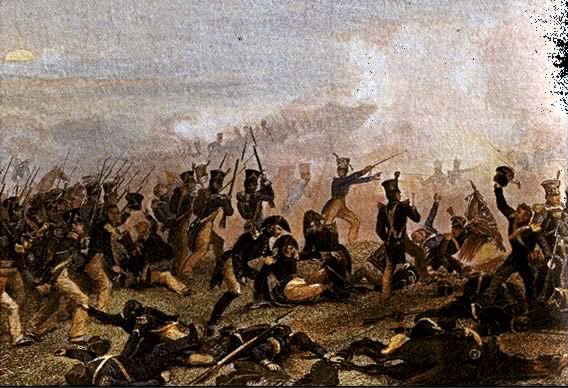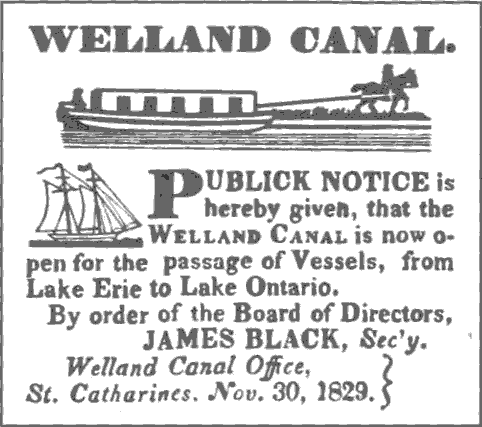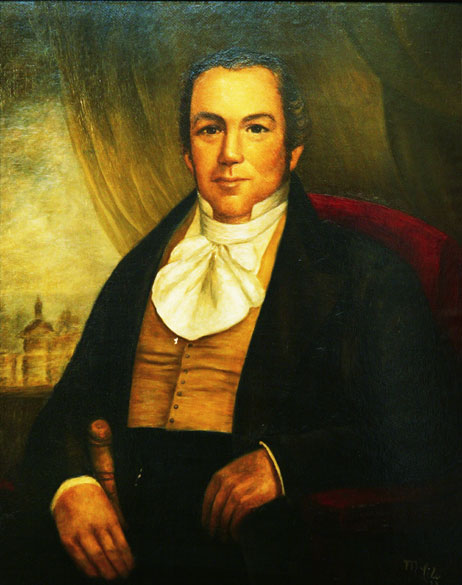|
David Thompson (Canada West Politician)
David Thompson (February 4, 17931851) was an entrepreneur and a political figure in Canada West. He represented Haldimand in the Legislative Assembly of the Province of Canada from 1841 to 1851 as a Reformer. Biography Thompson was born on February 4, 1793 in Stamford, Upper Canada. His father, James Thomson (or Thompson), was a Scottish Presbyterian from the town of Hawick in Roxburghshire near the Anglo-Scottish border. James had immigrated to the Niagara Peninsula in 1785, becoming an early settler there. James was described as stern and enterprising, and he and his sons fired their own bricks to construct a brick house. With the outbreak of the War of 1812, nineteen-year-old David enlisted in the militia, quickly becoming a sergeant in the 2nd Regiment of the Lincoln Militia. He fought at a number of conflicts along the war's Niagara Frontier, including Queenston Heights, Beaver Dams, Chippawa, Lundy's Lane (where he sustained a head wound), and Fort Erie, as well a ... [...More Info...] [...Related Items...] OR: [Wikipedia] [Google] [Baidu] |
Stamford, Ontario
Stamford Township is a former incorporated and now geographic township in Upper Canada, later Ontario, on the Niagara Peninsula. It was originally designated Township #2 in the Home District of the Quebec Colony in Canada. Following the creation of Upper Canada in 1791, Township #2 was renamed Stamford and placed within the newly created County of Lincoln. When Lincoln county was divided into Lincoln (north) and Welland (south) counties in 1851, Township #2 was placed in Welland County. The first survey took place around 1776, during the American Revolutionary War. Twelve European-American families came to settle in the area, including the Cooks and Durhams from New Jersey. It was developed and settled initially by Loyalists, primarily from New York State and other areas of the British colonies with the first two settlers being the Thomas McMicking and Philip Bender families. and later the Thompson and Bastedo families, among numerous others. The British Crown granted land ... [...More Info...] [...Related Items...] OR: [Wikipedia] [Google] [Baidu] |
Canadian Units Of The War Of 1812
When the United States and the United Kingdom went to war against each other in 1812, the major land theatres of war were Upper Canada (broadly the southern portion of the present day province of Ontario), Michigan Territory, Lower Canada (roughly the southern part of present-day Quebec) and the Maritime Provinces of Nova Scotia, New Brunswick, Prince Edward Island and Cape Breton (colony between 1784 and 1820). Each of the separate British administrations formed regular and fencible units, and both full-time and part-time militia units, many of which played a major part in the fighting over the two and a half years of the war. Fencibles Fencibles were military units raised on the same terms as regular troops, but liable for service only in North America. Atlantic provinces New Brunswick Regiment of Fencible Infantry This regiment was raised in 1803. Although established as Fencibles, the regiment volunteered for general service, and became the 104th (New Brunswick) Re ... [...More Info...] [...Related Items...] OR: [Wikipedia] [Google] [Baidu] |
William Hamilton Merritt
William Hamilton Merritt (July 3, 1793July 5, 1862) was a businessman and politician in the Niagara Peninsula of Upper Canada in the early 19th century. Although he was born in the United States, his family was Loyalist and eventually settled in Upper Canada. Merritt fought in the War of 1812, was captured by the invading American forces, and held as a prisoner of war. After the war, he returned to the Niagara region and began a career in business. He was one of the founders of the Welland Canal. Family and early life Merritt was born in Bedford in Westchester County, New York on July 3, 1793. His father, Thomas, fought as a United Empire Loyalist in the American Revolutionary War. After the revolution, the family resided in New Brunswick before returning to the U.S. In 1795, they moved to Upper Canada, settling on the Niagara Peninsula on the Twelve Mile Creek. Merritt attended school in Ancaster and Niagara, studying mathematics and field surveying. Afterwards, he b ... [...More Info...] [...Related Items...] OR: [Wikipedia] [Google] [Baidu] |
First Welland Canal
The Welland Canal has gone through many incarnations in its history. Today, five distinct canal-construction efforts are recognized. The retronym First Welland Canal is applied to the original canal, constructed from 1824 to 1829 and 1831 to 1833. Pre-canal times The Great Lakes form an excellent navigation route into the interior of North America. Downstream from Niagara Falls, ships can reach the port city of Montreal without encountering major difficulties. Upstream, the lakes are navigable all the way to the western end of Lake Superior. Early on during the European settlement of North America, lack of other infrastructure made the Great Lakes the premier route to reach the interior of the continent, and later to ship materials and goods from the new frontiers. The Niagara Falls stood as a mighty barrier. To bypass it, a portage road between Queenston, Ontario and Chippawa was used, but the solution was far from optimal. The cargo had to be unloaded, carried 18 km up the ... [...More Info...] [...Related Items...] OR: [Wikipedia] [Google] [Baidu] |
Distiller
Distillation, or classical distillation, is the process of separating the components or substances from a liquid mixture by using selective boiling and condensation, usually inside an apparatus known as a still. Dry distillation is the heating of solid materials to produce gaseous products (which may condense into liquids or solids); this may involve chemical changes such as destructive distillation or cracking. Distillation may result in essentially complete separation (resulting in nearly pure components), or it may be a partial separation that increases the concentration of selected components; in either case, the process exploits differences in the relative volatility of the mixture's components. In industrial applications, distillation is a unit operation of practically universal importance, but is a physical separation process, not a chemical reaction. An installation used for distillation, especially of distilled beverages, is a distillery. Distillation includes the fol ... [...More Info...] [...Related Items...] OR: [Wikipedia] [Google] [Baidu] |
Miller
A miller is a person who operates a Gristmill, mill, a machine to grind a grain (for example corn or wheat) to make flour. Mill (grinding), Milling is among the oldest of human occupations. "Miller", "Milne" and other variants are common surnames, as are their equivalents in other languages around the world ("Melnyk (surname), Melnyk" in Russian language, Russian, Belorussian language, Belorussian & Ukrainian language, Ukrainian, "Meunier (other), Meunier" in French language, French, "Müller (surname), Müller" or "Mueller (surname), Mueller" in German language, German, "Mulder" and "Molenaar" in Dutch language, Dutch, "Molnár" in Hungarian language, Hungarian, "Molinero" in Spanish language, Spanish, "Molinaro" or "Molinari" in Italian language, Italian etc.). Milling existed in hunter-gatherer communities, and later millers were important to the history of agriculture, development of agriculture. The materials ground by millers are often foodstuffs and particularly c ... [...More Info...] [...Related Items...] OR: [Wikipedia] [Google] [Baidu] |
Wainfleet, Ontario
Wainfleet is a rural township in southern Niagara Region, Ontario, Canada. There is a small and growing tourist industry, near and on Lake Erie at the southern area of Wainfleet called Long Beach. Wainfleet is also the home of the Marshville Heritage Village, a living history museum, recreating life in Ontario c. 1850-1910. Communities The township includes the communities of Attercliffe, Beckett's Bridge, Belleview Beach, Burnaby, Camelot Beach, Chambers Corners, Long Beach, Morgan's Point, O'Reilly's Bridge, Ostryhon Corners, Perry, Wainfleet (known until the 1920s as Marshville), Wellandport (which straddles the border with the neighbouring Township of West Lincoln), Willow Bay and Winger. Wainfleet is near Willow Bay. The administrative offices of the township are located in Wainfleet. Coat of arms Wainfleet Township's Coat of Arms consists of a white shield depicting a red cross, which symbolizes the arms of Lincoln, England, with a maple leaf in its centre. The maple l ... [...More Info...] [...Related Items...] OR: [Wikipedia] [Google] [Baidu] |
Capture Of Fort Niagara
The Capture of Fort Niagara took place late in 1813, during the War of 1812 between the United Kingdom and the United States. The American garrison was taken by surprise, and the fort was captured in a night assault by a select force of British regular infantry. Background Fort Niagara was an important American post near the outlet of the Niagara River into Lake Ontario. During the early days of the war, it was involved in several exchanges of artillery fire against the British at Fort George on the other side of the river. On 27 May 1813, the Americans won the Battle of Fort George. This left Fort George in their hands, and they briefly captured the entire Niagara peninsula, but they were then driven back to a narrow enclave around Fort George. Later during the year, almost all the regular soldiers on the Niagara front were redeployed to Sacket's Harbor to take part in an attack down the Saint Lawrence River against Montreal. They had briefly been replaced by regulars from t ... [...More Info...] [...Related Items...] OR: [Wikipedia] [Google] [Baidu] |
Siege Of Fort Erie
The siege of Fort Erie, also known as the Battle of Erie, from 4 August to 21 September 1814, was one of the last engagements of the War of 1812, between British and American forces. It took place during the Niagara campaign, and the Americans successfully defended Fort Erie against a British army. During the siege, the British suffered high casualties in a failed storming attempt; they also suffered casualties from sickness and exposure in their rough encampments. Unaware that the British were about to abandon the siege, the American garrison launched a sortie to destroy the British siege batteries, during which both sides again suffered high losses. After the British abandoned the siege, the reinforced American army followed up cautiously and forced a second retreat at Cook's Mills but, with the onset of winter and shortage of supplies, they withdrew. They demolished Fort Erie before leaving the area. The attempted siege ended one of the last British offensives along the northe ... [...More Info...] [...Related Items...] OR: [Wikipedia] [Google] [Baidu] |
Battle Of Lundy's Lane
The Battle of Lundy's Lane, also known as the Battle of Niagara, was a battle fought on 25 July 1814, during the War of 1812, between an invading American army and a British and Canadian army near present-day Niagara Falls, Ontario. It was one of the bloodiest battles of the war, and one of the deadliest battles ever fought in Canada, with over 1,731 casualties including 258 killed. The two armies fought each other to a stalemate; neither side held firm control of the field following the engagement. However, the casualties suffered by the Americans precipitated their withdrawal, and the British held the strategic initiative. Background On 3 July 1814 an American army under Major General Jacob Brown launched an attack across the Niagara River near its source on Lake Erie. His force quickly captured the British position at Fort Erie and then advanced north. Two days later one of his two brigades of regular U.S. Infantry under Brigadier General Winfield Scott defeated a British f ... [...More Info...] [...Related Items...] OR: [Wikipedia] [Google] [Baidu] |
Battle Of Chippawa
The Battle of Chippawa, also known as the Battle of Chippewa, was a victory for the United States Army in the War of 1812, during its invasion on July 5, 1814, of the British Empire's colony of Upper Canada along the Niagara River. This battle and the subsequent Battle of Lundy's Lane demonstrated that trained American troops could hold their own against British regulars. The battlefield is preserved as a National Historic Site of Canada. Background Early in 1814, it was clear that Napoleon was defeated in Europe, and seasoned British veteran soldiers from the Peninsular War would be redeployed to Canada. The United States Secretary of War, John Armstrong Jr., was eager to win a victory in Canada before British reinforcements arrived there. Major General Jacob Brown was ordered to form the Left Division of the Army of the North. Armstrong intended him to mount an attack on Kingston, the main British base on Lake Ontario, with a diversion by militia across the Niagara River to ... [...More Info...] [...Related Items...] OR: [Wikipedia] [Google] [Baidu] |







